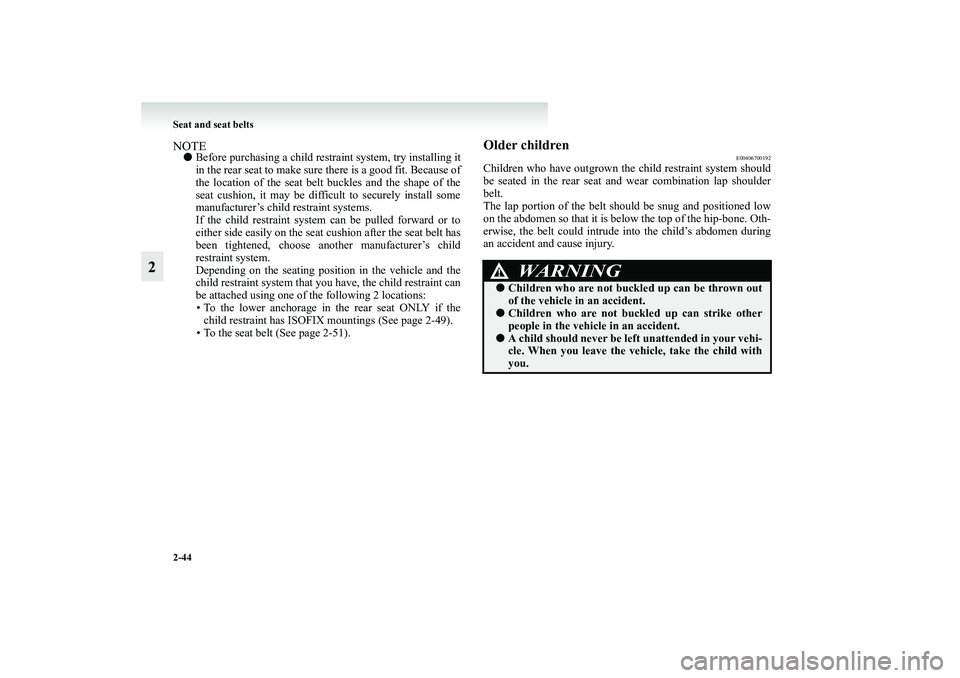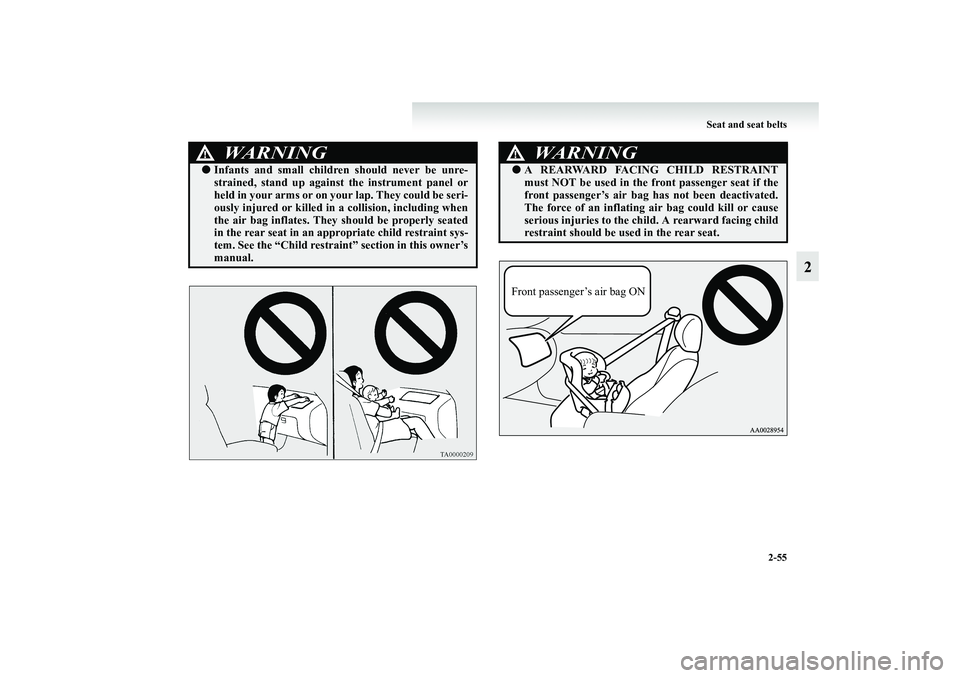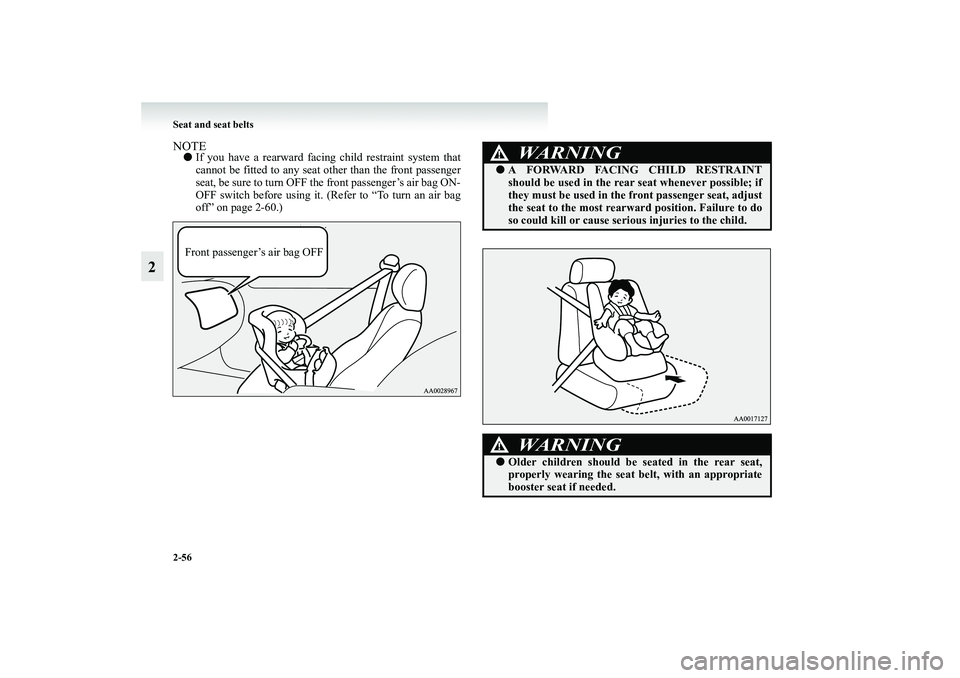2008 MITSUBISHI GRANDIS warning
[x] Cancel search: warningPage 91 of 458

Seat and seat belts
2-43
2
Infants and small children
E00406600579
When transporting infants and small children in your vehicle,
follow the instruction given below.Instruction:●For small infants, an infant carrier should be used. For
small children whose height when seated allows the
shoulder belt to lie in contact with the face or the throat, a
child seat should be used.
●The child restraint system should be appropriate for your
child’s weight and height and properly fit the vehicle. For
a higher degree of safety: THE CHILD RESTRAINT
SYSTEM SHOULD BE INSTALLED IN THE REAR
SEAT.
WARNING
!●When installing a child restraint system, refer to the
instructions provided by the manufacturer of the
restraint system. Failure to do so can result in severe
or fatal injury to your child.●After installation, push and pull the child restraint
system back and forth, and side to side, to see that it
is positively secured. If the child restraint system is
not installed securely, it may cause injury to the
child or other occupants in the case of accident or
sudden stops.●When the child restraint system is not in use, keep
your child or infant seat secured with the seat belt or
remove it from the vehicle in order to prevent injury
to your child.
BK-XP08E1ENUK.en-uk.book Page 43 Monday, August 13, 2007 2:20 PM
Page 92 of 458

2-44 Seat and seat belts
2
NOTE●Before purchasing a child restraint system, try installing it
in the rear seat to make sure there is a good fit. Because of
the location of the seat belt buckles and the shape of the
seat cushion, it may be difficult to securely install some
manufacturer’s child restraint systems.
If the child restraint system can be pulled forward or to
either side easily on the seat cushion after the seat belt has
been tightened, choose another manufacturer’s child
restraint system.
Depending on the seating position in the vehicle and the
child restraint system that you have, the child restraint can
be attached using one of the following 2 locations:
• To the lower anchorage in the rear seat ONLY if the
child restraint has ISOFIX mountings (See page 2-49).
• To the seat belt (See page 2-51).
Older children
E00406700192
Children who have outgrown the child restraint system should
be seated in the rear seat and wear combination lap shoulder
belt.
The lap portion of the belt should be snug and positioned low
on the abdomen so that it is below the top of the hip-bone. Oth-
erwise, the belt could intrude into the child’s abdomen during
an accident and cause injury.
WARNING
!●Children who are not buckled up can be thrown out
of the vehicle in an accident.●Children who are not buckled up can strike other
people in the vehicle in an accident.●A child should never be left unattended in your vehi-
cle. When you leave the vehicle, take the child with
you.
BK-XP08E1ENUK.en-uk.book Page 44 Monday, August 13, 2007 2:20 PM
Page 98 of 458

2-50 Seat and seat belts
2
To i n s t a l l
1. Slide the second seats to the fully backward position.
(Refer to “To adjust forward or backward” on page 2-9.)
2. Open the gap a little between the seat cushion (A) and the
seatback (B) with your hand to locate the lower anchor-
ages (C).
3. Push the child restraint system’s connectors into the lower
anchorages (C) in accordance with the instructions pro-
vided by the child restraint system’s manufacturer.
4. Remove the head restraint from the location in which you
wish to install a child restraint.
WARNING
!●If a child restraint system other than a MITSUBI-
SHI MOTORS genuine one is used, it may not be
properly retained and the child could be seriously
injured as a result. Use only a MITSUBISHI
MOTORS genuine child restraint system.
WARNING
!●If there is any foreign material in or around the con-
nectors, remove it before installing the child
restraint system. Also, make sure the seat belt is
away from, not looped through or otherwise inter-
fering with, the child restraint system. If foreign
matter is not removed and/or the seat belt interferes
with the child restraint system, the child restraint
system will not be secured properly and could move
forward in the event of sudden braking or a colli-
sion, seriously injuring the child and possibly other
vehicle occupants.●Use the top tether strap when fitting a child restraint
system with ISOFIX mountings.
Otherwise, the child could be seriously injured in
the event of hard braking or a collision.●When the vehicle is moving do not adjust the seat
where the child restraint system is installed.
BK-XP08E1ENUK.en-uk.book Page 50 Monday, August 13, 2007 2:20 PM
Page 100 of 458

2-52 Seat and seat belts
2Seat belt inspection
E00406300550
●Check the belts for cuts, worn or frayed webbing and for
cracked or deformed metallic parts. Replace the belt
assembly if detectable.
●A dirty belt should be cleaned with neutral detergent in
warm water. After rinsing in water, let it dry in the shade.
Do not attempt to bleach or re-dye the belts because this
affects their characteristics.
WARNING
!●For some types of child restraint, the locking clip (A)
should be used to help avoid personal injury during
a collision or sudden manoeuvre.
It must be fitted and used in accordance with the
child restraint manufacturer’s instructions.
The locking clip must be removed when the child
restraint is removed.
WARNING
!●We recommend you to have all seat belt assemblies
including retractors and attaching hardware
inspected after any collision. We recommend that
seat belt assemblies in use during a collision be
replaced unless the collision was minor and the belts
show no damage and continue to operate properly.●Do not attempt to repair or replace any part of the
seat belt assemblies; we recommend you to have this
work done by a MITSUBISHI MOTORS Author-
ized Service Point. Incorrect repair or replacement
could reduce the effectiveness of the belts and could
result in serious injury in the event of a collision.●Once the pre-tensioner has activated, it cannot be
re-used.
It must be replaced together with the retractor.
BK-XP08E1ENUK.en-uk.book Page 52 Monday, August 13, 2007 2:20 PM
Page 101 of 458

Seat and seat belts
2-53
2 Supplemental restraint system (SRS) -
air bag
E00407201377
The information written in this supplemental restraint system
(SRS) section contains important points concerning the driver,
front passenger, side and curtain air bags.
The SRS driver and front passenger air bags are designed to
supplement the primary protection of the driver and front pas-
senger side seat belt systems by providing those occupants
with protection against head and chest injuries in certain mod-
erate-to-severe frontal collisions.
The SRS driver and front passenger air bags employ a dual
stage air bag system. The SRS driver and front passenger air
bag is controlled by the impact sensors (at the front of the vehi-
cle and near the center of the vehicle at floor level) and the
driver’s seat position sensor. The SRS front passenger air bag
is controlled by the impact sensors.
The SRS side air bags are designed to supplement the seat belts
and provide the driver and front passenger with protection
against chest and abdomen injuries in certain moderate-to-
severe side impact collisions.
The SRS curtain air bags are designed to supplement the seat
belts and provide the driver and passenger with protection
against head injuries in certain moderate-to-severe side impact
collisions.The SRS is NOT a substitute for the seat belts; for maximum
protection in all types of crashes and accidents, seat belts
should ALWAYS be worn by everyone who drives or rides in
this vehicle. (With infants and small children in child restraints
and older children buckled in the rear seat.)
WARNING
!●IT IS VERY IMPORTANT TO ALWAYS PROP-
ERLY WEAR YOUR SEAT BELT, EVEN WITH
AN AIR BAG:
• Seat belts help keep the driver and passenger
properly positioned, which reduces injury risk in
all collisions, and reduces the risk of serious or
fatal injuries when the air bags inflate.
During sudden braking just before a collision, an
unrestrained or improperly restrained driver or
passenger can move forward into direct contact
with or within close proximity to the air bag which
may then deploy during the collision.
The initial stage of air bag inflation is the most
forceful which could cause serious or fatal injuries
if the occupant contacts it at this stage.
• Seat belts reduce the risk of injury in roll-overs,
rear impact collisions, and in lower-speed frontal
collisions, because driver’s and passenger’s air
bags are not designed to inflate in those situations.
• Seat belts reduce the risk of being thrown from
your vehicle in a collision or roll-over.
BK-XP08E1ENUK.en-uk.book Page 53 Monday, August 13, 2007 2:20 PM
Page 102 of 458

2-54 Seat and seat belts
2
WARNING
!●IT IS VERY IMPORTANT TO BE PROPERLY
SEATED.
A driver or front passenger too close to the steering
wheel or instrument panel during air bag deploy-
ment can be killed or seriously injured.
Air bags inflate very fast, and with great force.
If the driver and front passenger are not properly
seated and restrained, the air bags may not protect
you properly, and could cause serious or fatal inju-
ries when it inflates.
• Before driving, adjust the driver’s seat as far back
as possible while still maintaining complete control
of the vehicle.
• Before driving, adjust the front passenger seat as
far back as possible.
• Make sure all vehicle occupants are always prop-
erly restrained using the available seat belts.
• With seat belts properly fastened, the driver and
passenger should sit well back and upright without
leaning against the window or door.
WARNING
!●Do not sit on the edge of the seat, or lean head or
chest close to the steering wheel or instrument panel.
Do not put feet or legs on or against the instrument
panel.●Place all infants and small children in the rear seat
and properly restrained using an appropriate child
restraint system.
The rear seat is the safest for infants and children.
BK-XP08E1ENUK.en-uk.book Page 54 Monday, August 13, 2007 2:20 PM
Page 103 of 458

Seat and seat belts
2-55
2
WARNING
!●Infants and small children should never be unre-
strained, stand up against the instrument panel or
held in your arms or on your lap. They could be seri-
ously injured or killed in a collision, including when
the air bag inflates. They should be properly seated
in the rear seat in an appropriate child restraint sys-
tem. See the “Child restraint” section in this owner’s
manual.
WARNING
!●A REARWARD FACING CHILD RESTRAINT
must NOT be used in the front passenger seat if the
front passenger’s air bag has not been deactivated.
The force of an inflating air bag could kill or cause
serious injuries to the child. A rearward facing child
restraint should be used in the rear seat.Front passenger’s air bag ON
BK-XP08E1ENUK.en-uk.book Page 55 Monday, August 13, 2007 2:20 PM
Page 104 of 458

2-56 Seat and seat belts
2
NOTE●If you have a rearward facing child restraint system that
cannot be fitted to any seat other than the front passenger
seat, be sure to turn OFF the front passenger’s air bag ON-
OFF switch before using it. (Refer to “To turn an air bag
off” on page 2-60.)Front passenger’s air bag OFF
WARNING
!●A FORWARD FACING CHILD RESTRAINT
should be used in the rear seat whenever possible; if
they must be used in the front passenger seat, adjust
the seat to the most rearward position. Failure to do
so could kill or cause serious injuries to the child.
WARNING
!●Older children should be seated in the rear seat,
properly wearing the seat belt, with an appropriate
booster seat if needed.
BK-XP08E1ENUK.en-uk.book Page 56 Monday, August 13, 2007 2:20 PM